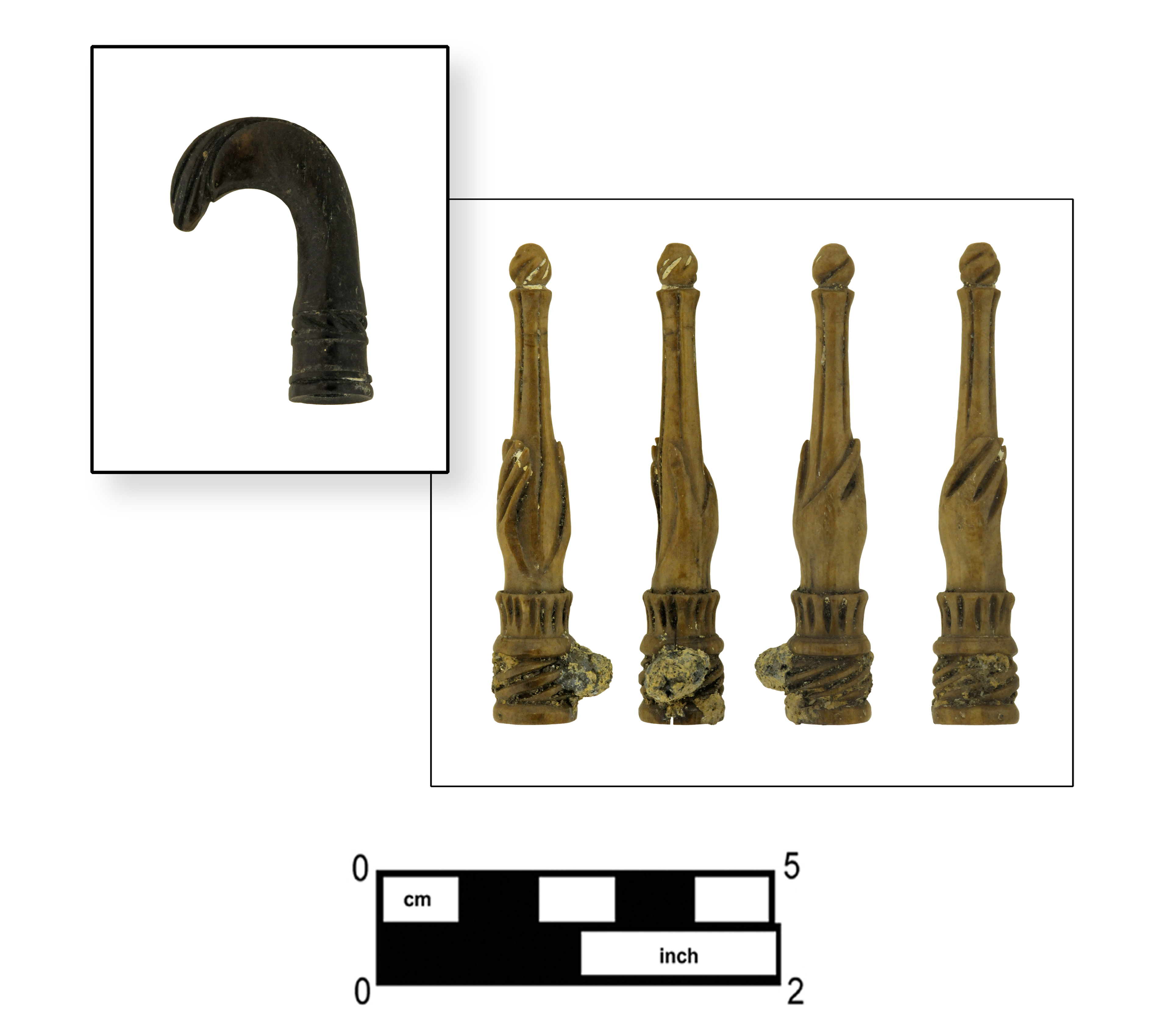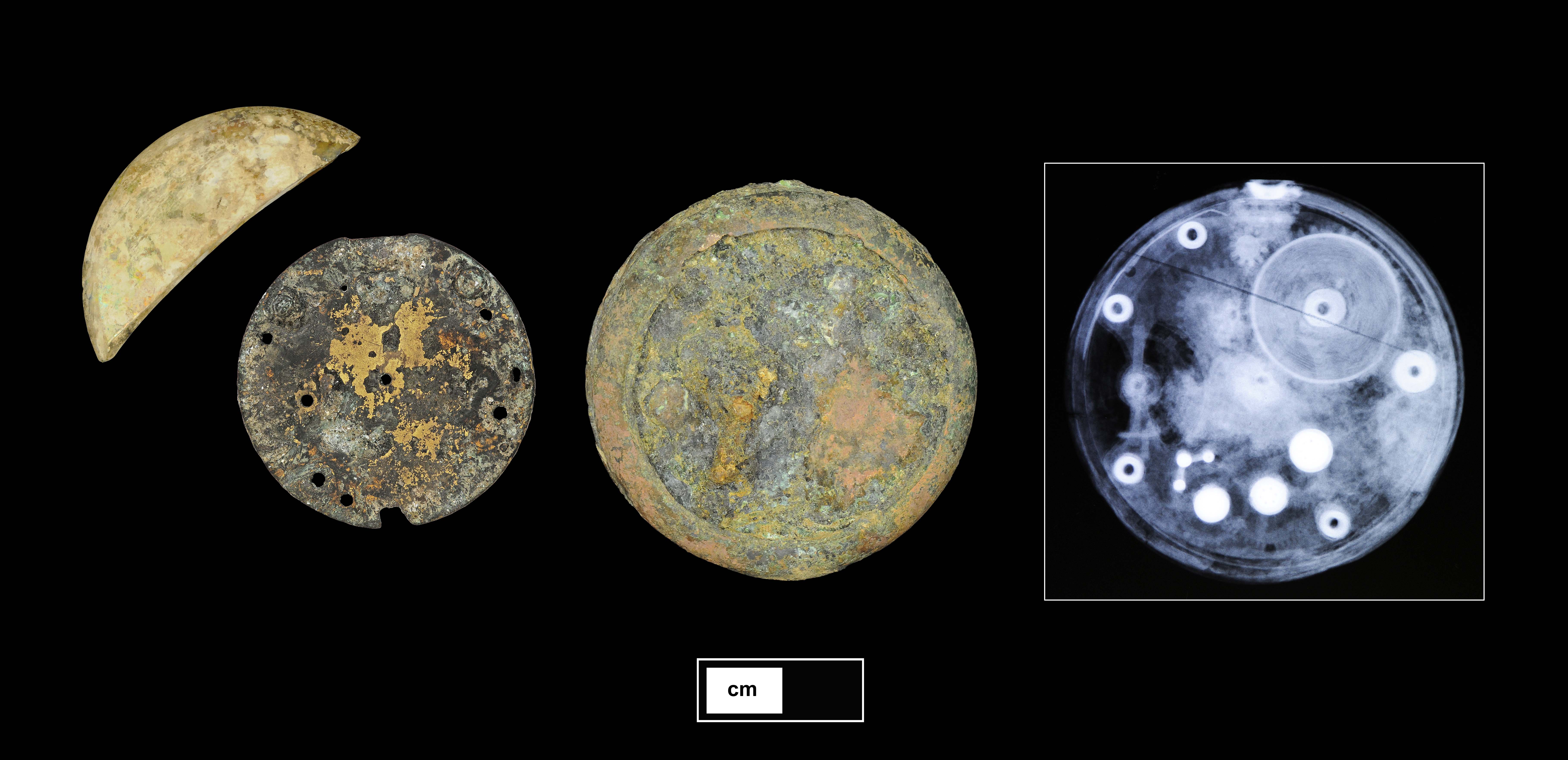Several artifacts recovered from this feature represent remnants of fashion accessories and period timepieces. While fabric seldom survives, other pieces of evidence—such as ivory handles and metal hardware—suggest an awareness of fashion among the residents of this household.
Parasol Parts

Two hand-carved pieces recovered from this feature appear to be parts from parasols—primarily used by women to shield their skin from the sun. While there are no markings on either piece to indicate where they were made, by the mid-nineteenth century, Philadelphia was one of the leading manufacturing centers for parasols and umbrellas. In the 1860s, the various parts that made up parasols and umbrellas were each manufactured separately from one another: frames were made apart from sticks, and heads were carved separately from tips. 1 Parasol handles and ends were made from a variety of different materials, including ivory, bone, and wood. 2
One example from this feature is carved from ivory and features a hand holding an unidentified rod-shaped object with a small spire-shaped tip (Cat # 4.24.530). This piece measures 2.25 inches in length and was probably the end cap from the top of a parasol. The wrist portion contains a hollow socket, measuring 0.2 inches in diameter and approximately 0.7 inches deep, to connect the piece to the top of a parasol stick. A heavily corroded copper alloy fastener that once secured the piece to the stick is still attached on the outside of the socket.
The other piece appears to be carved from dark wood with less attention to ornamental detail (Cat # 4.31.107). This crook-shaped object, measuring only 1.4 inches in length, resembles a small parasol handle, possibly from a child’s parasol or a toy parasol. Alternatively, the fragment may have been a different type of top element from an adult parasol; some styles had a smaller crook at the top, to allow them to be carried from either end when folded.
Pocket Watches

Three of the artifacts recovered from this shaft feature are associated with nineteenth-century timepieces. The artifacts consist of a nearly complete pocket watch, a metal plate from a second watch, and a portion of a glass cover or watch crystal.
The outer case of the pocket watch measures 2 inches in diameter and is 0.6 inches thick (4.1622.607). The watch case appears to be constructed of a copper alloy and may represent an example of plated brass. 3 This type of watch would have had an exposed dial, referred to as an open face. 4 Originally, a slightly convex glass called a crystal or watch cover covered the dial.
Sections of the watch case are missing, as is the winding stem, and the features of the dial are no longer visible. In the x-ray taken by Maryland Archaeological Conservation Laboratory, the internal movement seems to be intact. The main spring and balance wheel are visible, and other wheels and gears appear to be in the proper position. 5
Mr. D. Stuart at PocketWatchRepair.com responded to our request for his analysis and identified some of the internal components:
The large circle in the upper right quadrant is the mainspring barrel… it appears the mainspring is still wound inside, though in pieces. The bright spots with the black centers are (probably) screws… plate screws and bridge screws… The other bright spots are probably jewel settings… and it appears to be a 15-jewel, lever-escapement. The layout of the mechanism, with the 4th wheel directly opposite the winding stem, tells me that the movement was intended for an open-face watch (not Hunter-cased) so that would be consistent with the thicker beveled-edge crystal fragment you found. Style of construction suggests that it is a Swiss watch… (based on the position of the winding pinion, the setting mechanism, and the layout of the screws on the balance wheel).
Mr. Stuart saw “nothing that would definitively date the watch.” However, he added: “It does appear to be a ¾ plate movement (recessed balance) which would indicate later construction than the full-plate movements which were common in the 1860s–1880s.”
A flat metal disk, roughly circular in shape, was also recovered from deeper within this feature (Cat # 4.40.23). The disk appears to be copper alloy with evidence of gilding on both surfaces. The size of the disk (41 millimeters, or 1.6 inches, in diameter and approximately 1.57 millimeters thick), numerous round perforations, and a few pin-like projections suggest this artifact is another watch part. We sent an image and measurements to Mr. Stuart, who replied “it’s a pretty good match for a main plate for a 14-size watch.” 6 He further explained: “Waltham made some 14-size watches (their Colonial series) and there may have been other manufacturers who made 14-size, but 12-size and 16-size were much more common.”
The broken fragment of a glass watch crystal was also recovered from the same level as the main plate described above (Cat # 4.39.16). The outer edge of the crystal is beveled. The crystal measures 2.04 millimeters in thickness, with an estimated diameter of 46 millimeters. Mr. Stuart explained that “typical glass thickness for an open face beveled crystal is 1.0 mm–1.5mm, but can be up to 2.5mm.” 7
The nearly complete pocket watch was recovered from the strat containing material that appeared to relate to members of both the Cramp and Bumm households. It is not clear how the pocket watch ended up in the privy. The two fragments were recovered from the same level deeper within the feature and were probably deposited while members of the Cramp family were living on the property.
References
- Edwin Troxell Freedley, Philadelphia and Its Manufactures: A Hand-book Exhibiting the Development, Variety and Statistics of the Manufacturing Industry of Philadelphia in 1857 (Philadelphia, PA: Edward Young, 1857), 390. ↩
- Bloomingdale Brothers, Bloomingdale’s Illustrated 1886 Catalog (New York, NY: Dover Publications, Inc., 1988), 109. ↩
- Cooksey Shugart and Darold Hanson, Collecting Watches (New York, NY: Random House, Inc., 2004), 40, 41. ↩
- D. Stuart, “Identifying Pocket Watch and Pocket Watch Case Types,” Renaissance Watch Repair, accessed August 22, 2017, http://www.pocketwatchrepair.com/how-to/identify-pocketwatch-cases.php. ↩
- Shugart and Hanson, Collecting Watches, 52–54. ↩
- D. Stuart, “How to Determine the Size of Your Watch,” Renaissance Watch Repair, accessed October 16, 2017, http://www.pocketwatchrepair.com/how-to/watch-size.php. ↩
- D. Stuart, “All About Vintage Pocket Watch Crystals,” Renaissance Watch Repair, accessed October 16, 2017, http://www.pocketwatchrepair.com/how-to/crystals.php. ↩







